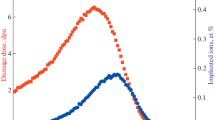Abstract
Titanium aluminides are well-accepted elevated temperature materials. In conventional applications, their poor oxidation resistance limits the maximum operating temperature. Advanced reactors operate in nonoxidizing environments. This could enlarge the applicability of these materials to higher temperatures. The behavior of a cast gamma-alpha-2 TiAl was investigated under thermal and irradiation conditions. Irradiation creep was studied in beam using helium implantation. Dog-bone samples of dimensions 10 × 2 × 0.2 mm3 were investigated in a temperature range of 300 °C to 500 °C under irradiation, and significant creep strains were detected. At temperatures above 500 °C, thermal creep becomes the predominant mechanism. Thermal creep was investigated at temperatures up to 900 °C without irradiation with samples of the same geometry. The results are compared with other materials considered for advanced fission applications. These are a ferritic oxide-dispersion-strengthened material (PM2000) and the nickel-base superalloy IN617. A better thermal creep behavior than IN617 was found in the entire temperature range. Up to 900 °C, the expected 104 hour stress rupture properties exceeded even those of the ODS alloy. The irradiation creep performance of the titanium aluminide was comparable with the ODS steels. For IN617, no irradiation creep experiments were performed due to the expected low irradiation resistance (swelling, helium embrittlement) of nickel-base alloys.









Similar content being viewed by others
References
J. Lapin and M. Nazmy: Mater. Sci. Eng. A, 2004, vol. 380, pp. 298–307.
E.A. Loria: Intermetallics, 2000, vol. 8, pp. 1339–45.
T. Tetsui: Mater. Sci. Eng. A, 2002, vols. 329–331, pp. 582–88.
A Technology Roadmap for Generation IV Nuclear Systems, U.S. Department of Energy, 2002, http://gif.inel.gov/roadmap/pdfs/gen_iv_roadmap.pdf.
M. Es-Souni, A. Bartels, and R. Wagner: Acta Metall. Mater., 1995, vol. 43 (1), pp. 153–61.
M.A. Morris and T. Lipe: Intermetallics, 1997, vol. 5, pp. 329–37.
T.A. Parthasarathy, M.G. Mendiratta, and D.M. Dimiduk: Scripta Mater., 1997, vol. 37 (3), pp. 315–21.
J.G. Wang, L.M. Hsiung, and T.G. Nieh: Intermetallics, 1999, vol. 7, pp. 757–63.
L.M. Hsiung and T.G. Nieh: Intermetallics, 1999, vol. 7, pp. 821–27.
C.E. Wen, K. Yasue, J.G. Lin, Y.G. Zhang, and C.Q. Chen: Intermetallics, 2000, vol. 8, pp. 525–29.
M. Nazmy and M. Staubli: U.S. Patent 5,207,982 and EP. 45505 B1.
W.M. Yin, V. Lupinc, and L. Battezzati: Mater. Sci. Eng. A, 1997, vols. 239–240, pp. 713–21.
J.P. Biersack and L.G. Haggmark: Nucl. Instr. Meth., 1980, vol. 174, p. 93.
J.F. Ziegler, J.P. Biersack, and U. Littmark: The Stopping and Range of Ions in Solids, Pergamon, New York, NY, 1985.
P. Jung, A. Schwartz, and H.K. Sahu: Nucl. Instr. Meth. A, 1985, vol. 234, pp. 331–34.
W. Hoffelner, M. Staubli, A. Czeratzki, and R.B. Scarlin: Residual Life Assessments of Steam Turbine Components with the “Isostress”-Method, ABB Metals Laboratories, Baden, Switzerland, unpublished research, 1982–1984.
W.M. Yin, V. Lupinc, and L. Battezzati: Mater. Sci. Eng. A, 1997, vol. 239–240, pp. 713–21.
R.J. Puigh: in Effects of Radiation in Materials, F.A. Garner and J.F. Perrin, eds., ASTM STP 870, ASTM, Philadelpia, PA, 1985, pp. 7–18.
J. Chen, M.A. Pouchon, A. Kimura, P. Jung, and W. Hoffelner: J. Nucl. Mater., 2009, vols. 386–388, pp. 143–46.
P. Yvon and F. Carré: J. Nucl. Mater., 2009, vol. 385, pp. 217–22.
F. Schubert, U. Bruch, R. Cook, H. Diehl, Ph.J. Ennis, W. Jakobeit, H.J. Penkalla, E. te Heesen, and G. Ullrich: Nucl. Technol., 1984, vol. 66, pp. 227–40.
H.-J. Penkalla, H.-H. Over, and F. Schubert: Nucl. Technol., 1984, vol. 66, pp. 685–92.
S. Chandra, R. Cotgrove, S.R. Holdsworth, M. Schwienheer, and M.W. Spindler: Creep Rupture Data Assessments of Alloy 617, Creep and Fracture in High Temperature Components, ECCC Creep Conf., London, Sept. 2005, pp. 178–88.
J.F. dos Reis Sobrinho and L. Oliveira Bueno: Rev. Matéria, 2005, vol. 10 (3), pp. 463–71.
W. Hoffelner: in High Temperature Alloys for Gas Turbines and other Applications, W. Betz, R. Brunetaud, D. Coutsouradis, H. Fischmeister, T.B. Gibbons, I. Kvernes, Y. Lindblom, J.B. Marriott, and D.B. Meadowcroft, eds., D. Reidel Publishing Company, Dordrecht, 1986, pp. 413–40.
W. Hoffelner and M. Staubli: ABB Metals Laboratories, Baden, Switzerland, unpublished research, 1985.
J. Chen and W. Hoffelner: J. Nucl. Mater., 2009, vol. 392 (2), pp. 360–63.
A.I. Ryazanov: “Modern Problems of Irradiation-Induced Plastic Deformation in Irradiated Structural Materials,” Poster presented at Dislocations 2004, La Colle-sur-Loup, France, Sept. 13–17, 2004.
Author information
Authors and Affiliations
Corresponding author
Additional information
This article is based on a presentation given in the symposium “Materials for the Nuclear Renaissance,” which occurred during the TMS Annual Meeting, February 15–19, 2009, in San Francisco, CA, under the auspices of Corrosion and Environmental Effects and the Nuclear Materials Committees of ASM-TMS.
Rights and permissions
About this article
Cite this article
Magnusson, P., Chen, J. & Hoffelner, W. Thermal and Irradiation Creep Behavior of a Titanium Aluminide in Advanced Nuclear Plant Environments. Metall Mater Trans A 40, 2837–2842 (2009). https://doi.org/10.1007/s11661-009-0047-3
Published:
Issue Date:
DOI: https://doi.org/10.1007/s11661-009-0047-3



